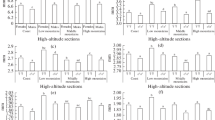Abstract
Adult body size is one of the most ecologically relevant quantitative traits that underlies many other life-history traits of particular organism. In insects, there is positive intraspecific relationship between body size and female fecundity. In this study small scale temporal and spatial and space variability in structural body size of Poecilus cupreus and Anchomenus dorsalis was investigated. The beetles were collected in four fields near Prague-Suchdol in autumn 2009 and 2010, and in spring 2010, 2011 and 2012. In both species structural body size was significantly affected by sex (females were the larger sex). In A. dorsalis structural body size was also significantly affected by arable field identity, overwintering (post-overwintering individuals collected in spring were larger in comparison to pre-overwintering individuals collected in autumn), sampling year, overwintering by year and arable field by year interactions. Our results suggest that spatiotemporal variation in environmental conditions experienced by A. dorsalis during larval growth resulted in differences in adult structural body size among particular fields and particular sampling years. In addition, mean structural body size in A. dorsalis was affected by overwintering, which was probably caused by size-specific winter mortality. Moreover, effect of overwintering varied among years, probably according to the specific weather conditions during a particular winter.
Similar content being viewed by others
References
Blanckenhorn W.U., Demont M., Bergmann and Converse Bergmann latitudinal clines arthropods: two ends of a continuum?, Integr. Comp. Biol., 2004, 44, 413–424
Chown S.L., Gaston K., Body size variation in insects: a macroecological perspective, Biol. Rev., 2010, 85, 139–169
Yom-Tov Y., Geffen E., Recent spatial and temporalchanges in body size of terrestrial vertebrates: probable causes and pitfalls, Biol. Rev., 2011, 86, 531–541
Honěk A., Intraspecific variation in body size and fecundity in insects: a general relationship, Oikos, 1993, 66, 483–492
Blanckenhorn W.U., Fanti J., Reim C., Sizedependent energy reserves, energy utilization and longevity in the yellow dung fly, Physiol. Entomol., 2007, 32, 372–381
Peixoto P.E.C., Benson W.W., Body mass and not wing length predicts territorial success in a tropical satyrine Butterfly, Ethology, 2008, 114, 1069–1077
Kovacs J.L., Goodisman M.A., Effects of size, shape, genotype, and mating status on queen overwintering survival in the social wasp Vespula maculifrons, Environ. Entomol., 2012, 41, 1612–1620
Tsuchiya Y., Takami Y., Okuzaki Y., Sota T., Genetic differences and phenotypic plasticity in body size between high- and low-altitude populations of the ground beetle Carabus tosanus, J. Evol. Biol., 2012, 25, 1835–1842
Stillwell R.C., Are latitudinal clines in body size adaptive?, Oikos, 2010, 11, 1387–1390
Kingsolver J.G., Huey R.B., Size, temperature, and fitness: three rules, Evol. Ecol. Res., 2008, 10, 251–268
Östman Ö., Asynchronous temporal variation among in condition of two carabid species, Ecol. Entomol., 2005, 30, 63–69
Knapp M., Knappová J., Measurement of body condition in a common carabid beetle, Poecilus cupreus: a comparison of fresh weight, dry weight, and fat content, J. Insect Sci., 2013, 13, 1–10
Bommarco R., Reproduction and energy reserves of predatory carabid beetle relative to agroecosystem complexity, Ecol. Appl., 1998, 8, 846–853
Karino K., Seki N., Chiba M., Larval nutritional environment determines adult size in Japanese horned beetles Allomyrina dichotoma, Ecol. Res., 2004, 19, 663–668
Lövei G.L., Sunderland K.D., Ecology and behavior of ground beetles (Coleoptera: Carabidae), Annu. Rev. Entomol., 1996, 41, 231–256
Chaabane K., Loreau M., Josens G., Growth and egg production in Abax ater (Coleoptera, Carabidae), Pedobiologia, 1997, 41, 385–396
Bilde T., Toft S., Quantifying food limitation of arthropod predators in the field, Oecologia, 1998, 115, 54–58
Bommarco R., Stage sensitivity to food limitation for a generalist Arthropod predator, Pterostichus cupreus (Coleoptera: Carabidae), Environ. Entomol., 1998, 27, 864–869
Östman Ö., Ekbom B., Bengtsson J., Weibul A., Landscape complexity and farming practice influence the condition of polyphagous carabid beetles, Ecol. Appl., 2001, 11, 480–488
Barone M., Frank T., Habitat age increases reproduction and nutritional condition in a generalist arthropod predator, Oecologia, 2003, 135, 78–83
Andersen A., Densities of overwintering carabids and staphylinids (Col. Carabidae and Staphylinidae) in cereal and grass fields and their boundaries, J. Appl. Entomol., 1997, 121, 77–80
Leathers S.R., Walters K.F., Bale J.S., The ecology of insect overwintering, Cambridge University Press, New York, 1995
Hůrka K., Carabidae of the Czech and Slovak Republics, Kabourek, Zlín, 1996
Holland J., The agroecology of carabid beetle, Intercept, Andover, 2002
ter Braak C.J.F., Šmilauer P., CANOCO reference manual and CanoDraw for Windows user’s guide: software for canonical community ordination (version 4.5), Microcomputer Power, Ithaca, 2002
Blanckenhorn W.U, Dixon A.F.G., Fairbairn D.J., Foellmer M.W., Gibert P., van der Linde K., et al., Proximate causes of Rensch’s rule: does sexual size dimorphism in arthropods result from sex differences in development time?, Am. Nat., 2007, 169, 245–257
Stillwell R.C., Blanckenhorn W.U., Teder T., Davidowitz G., Fox Ch.W., Sex differences in phenotypic plasticity affect variation in sexual size dimorphism in insect: from physiology to evolution, Annu. Rev. Entomol., 2010, 55, 227–245
van Dijk T. S., On the relationship between food, reproduction and survival of two carabid beetles: Calathus melanocephalus and Pterostichus versicolor, Ecol. Entomol., 1994, 19, 263–270
Petersen M.K., Ekbom B., Ravn H.P., Temperature dependent winter survival of Bembidion lampros and Tachyporus hypnorum, J. Insect Physiol., 1996, 42, 997–1005
Lagisz M., Wolff K., Sanderson R.A., Laskowski R., Genetic population structure of the ground beetle, Pterostichus oblongopunctatus, inhabiting a fragmented and polluted landscape: Evidence for sex-biased dispersal, J. Insect Sci., 2010, 10, 1–20
Author information
Authors and Affiliations
Corresponding author
About this article
Cite this article
Baranovská, E., Knapp, M. Small-scale spatiotemporal variability in body size of two common carabid beetles. cent.eur.j.biol. 9, 476–494 (2014). https://doi.org/10.2478/s11535-013-0282-x
Received:
Accepted:
Published:
Issue Date:
DOI: https://doi.org/10.2478/s11535-013-0282-x




